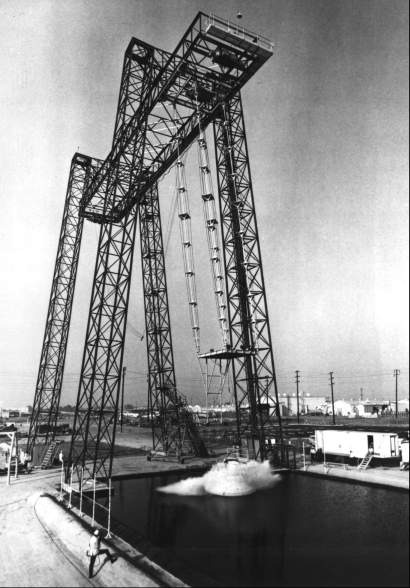Downey California; Home Of Apollo!

The North American Aviation plant at Downey, California, developed and produced the Apollo command module.
Storms' team operated from a two-story building in Downey, California. Design engineers and draftsmen occupied the major portion of the structure, their desks crowded together in cavernous halls.
An adjacent building housed the manufacturing activities for the space division. The site was so nig, we had busses run between buildings so the staff could get from Building 001 to Building 4 across Imperial Blvd.
Ninety percent of the property belonged to the federal government, but long-term leases had made North American, as tenant, virtually the proprietor.
Now, with the Apollo contract, plans were made to recruit personnel, to buy adjoining property, and to construct more buildings and facilities. In the meantime, some of the personnel worked out of house-trailer offices in the parking lots. We had trailers in nearly every parking lot.

The manpower buildup in Storms' division in the first six months of 1962 doubled the size of his organization - from 7,000 to more than 14,000 persons. Although many employees were busy on the Air Force's Hound Dog missile, among other projects, the newcomers for the most part were hired to develop the Apollo command and service modules.
The impact facility at North American was used to drop-test the CM on water, sand, gravel, and boulders to check structural integrity and impact loads.
One of the first structures built at Downey specifically for Apollo began to take shape early in 1962. The Impact Test Facility, 46 meters high, looked like a gigantic playground swing. It was a swing of sorts - one designed to hold and drop a command module so the Apollo team could study it and improve structural strengths of the heat shield, honeycomb shock absorbers, inner and outer shells, afterbody, and astronaut couches.
At one end of the swing was a pool of water, at the other a sandpile that could be banked or pitted with gravel and boulders. To return men safely from the moon required a knowledge of the exact limits they and their machine could endure at the final landing on earth.
To keep key personnel ready for the frequent meetings with NASA and aware of daily plant operations, Storms, Paup, Ryker, and Feltz held ten-minute briefings for all plant supervisors at the beginning of each morning shift. Agendas were carefully controlled; no interruptions were permitted; and everyone was required to speak for his section. Normal hours in those days was 6 to 8... 6am to 8pm! No 8 to 5's for most of us!
Thus, until North American's Apollo operation grew too large to make this kind of communication useful, all the major managers had at least one daily direct contact with their colleagues and superiors. Some of these sessions were devoted to plans for selecting and working with the subcontractors who would develop the subsystems.